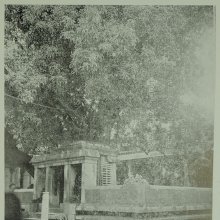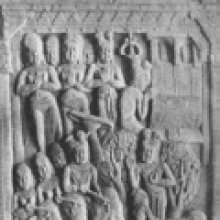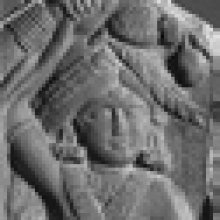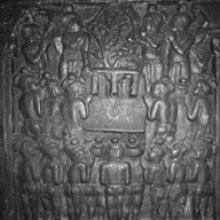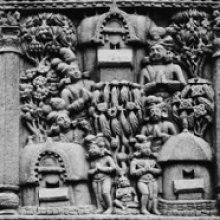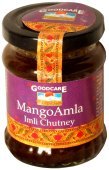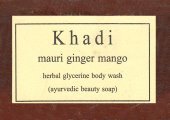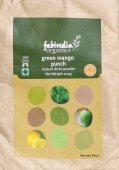Mango: 4 definitions
Introduction:
Mango means something in Hinduism, Sanskrit, biology. If you want to know the exact meaning, history, etymology or English translation of this term then check out the descriptions on this page. Add your comment or reference to a book if you want to contribute to this summary article.
Images (photo gallery)
(+4 more images available)
In Hinduism
Natyashastra (theatrics and dramaturgy)
Source: Shodhganga: Elements of Art and Architecture in the Trtiyakhanda of the Visnudharmottarapurana (natya)Mango (fruit) is associated with Padmakośa-hasta: one of the twenty-two Single-hand Gestures (in Indian Dramas) (known as asaṃyuktahastas), according to the Viṣṇudharmottarapurāṇa, an ancient Sanskrit text which (being encyclopedic in nature) deals with a variety of cultural topics such as arts, architecture, music, grammar and astronomy.—The word padmakośa means the calyx of a lotus. [...] The uses of the padmakośa-hasta posture are not mentioned in the Viṣṇudharmottarapurāṇa. But according to the Abhinayadarpaṇa, this posture denotes some round shaped objects like breast of a woman, ball, round shaped cooking pot, egg and bell. The padmakośa posture is also used to show the blowing buds of flowers like marigold, lotus etc. Some kind of fruits like mango and wood apple are also portrayed with his hand posture.

Natyashastra (नाट्यशास्त्र, nāṭyaśāstra) refers to both the ancient Indian tradition (shastra) of performing arts, (natya—theatrics, drama, dance, music), as well as the name of a Sanskrit work dealing with these subjects. It also teaches the rules for composing Dramatic plays (nataka), construction and performance of Theater, and Poetic works (kavya).
Shilpashastra (iconography)
Source: Shodhganga: Elements of Art and Architecture in the Trtiyakhanda of the Visnudharmottarapurana (shilpa)The Mango (tree) is denoted by the Sanskrit term Sahakāra and is involved in the legendary origins of the ancient Indian art of Painting, according to the Viṣṇudharmottarapurāṇa, an ancient Sanskrit text which (being encyclopedic in nature) deals with a variety of cultural topics such as arts, architecture, music, grammar and astronomy.—According to the Viṣṇudharmottarapurāṇa, Painting was created by the sage Nārāyaṇa while he was making the picture of the damsel Urvaśī. It is related in this book that extracting the juice from sahakāra i.e., mango tree, the sage Nārāyaṇa created the most beautiful woman in this world. Through the application of Painting, she became the most beautiful damsel. After that the sage Nārāyaṇa gave this knowledge of Painting to Viśvakarmā and thus this art form had received momentum through the ages.

Shilpashastra (शिल्पशास्त्र, śilpaśāstra) represents the ancient Indian science (shastra) of creative arts (shilpa) such as sculpture, iconography and painting. Closely related to Vastushastra (architecture), they often share the same literature.
Ayurveda (science of life)
Agriculture (Krishi) and Vrikshayurveda (study of Plant life)
Source: Asian Agri-History: Drumavichitrikaranam—The Ancient Approach to Plant MutagenesisMango (Identified with Mangifera indica) was used in the process of organic plant mutagenesis by ancient Indian agriculturists, which presents a safe technology and methodology regarding organic agriculture, according to treatises (such as the Vrikshayurveda). One such technology was to produce flowers and fruits on other species of plants and trees: The term drumavichitrikaranam (“plant mutagenesis”) obtains its true meaning in the literal sense through this objective. Some of them are described in the Upavanavinoda of Śārṅgadhara: such as to grow Mangifera indica (mango) fruits on Musa paradisiaca (plantain tree). Also: to grow Solanum indicum (poison berries) from Mangifera indica (mango) seeds.

Āyurveda (आयुर्वेद, ayurveda) is a branch of Indian science dealing with medicine, herbalism, taxology, anatomy, surgery, alchemy and related topics. Traditional practice of Āyurveda in ancient India dates back to at least the first millenium BC. Literature is commonly written in Sanskrit using various poetic metres.
Biology (plants and animals)
Source: Google Books: CRC World Dictionary (Regional names)1) Mango in India is the name of a plant defined with Dendrocalamus strictus in various botanical sources. This page contains potential references in Ayurveda, modern medicine, and other folk traditions or local practices It has the synonym Bambusa hexandra Roxb. ex Munro (among others).
2) Mango in Tanzania is also identified with Sclerocarya birrea It has the synonym Commiphora subglauca Engl. (etc.).
Example references for further research on medicinal uses or toxicity (see latin names for full list):
· Gard. Bull. Sing. (1958)
· Species Plantarum, ed. 4 (1799)
· Rev. Hort. (1876)
· Hort. Beng. (1814)
· Transactions of the Linnean Society of London (1868)
· Bamb. Res. Asia (1980)
If you are looking for specific details regarding Mango, for example health benefits, diet and recipes, side effects, chemical composition, extract dosage, pregnancy safety, have a look at these references.

This sections includes definitions from the five kingdoms of living things: Animals, Plants, Fungi, Protists and Monera. It will include both the official binomial nomenclature (scientific names usually in Latin) as well as regional spellings and variants.
See also (Relevant definitions)
Starts with (+6): Mango jobo, Mango juice, Mango-si, Mangoakoane, Mangodem, Mangodu, Mangol, Mangold, Mangoli, Mangoliya, Mangollano, Mangolovya, Mangombu, Mangona, Mangona mahagoni, Mangongot, Mangonibui, Mangoro, Mangosabolebo, Mangostan.
Ends with: African mango, Bitter bush mango, Bush mango, Dry season bush mango, Hill mango, Kasamango, Kati-mango, Komango, Mana mango, Manamango, Pepino mango, Rainy season bush mango, Sacha mango, Sweet bush mango, Wael mango, Wild mango, Wildemango.
Full-text (+814): Amra, Cuta, Rasala, Sahakara, Kamavallabha, Vasantaduta, Shareshta, Palaladohada, Makanda, Rajamra, Amravana, Madirasakha, Gandhabandhu, Kamashara, Dugdhataliya, Vanaspatya, Amarai, Kamayudha, Shivavallabha, Kairi.
Relevant text
Search found 195 books and stories containing Mango; (plurals include: Mangos). You can also click to the full overview containing English textual excerpts. Below are direct links for the most relevant articles:
A Mango for Me < [October – December, 2006]
Mango Blossom < [April – June and July – September, 1996]
An Arrival Auspicious < [April – June, 1999]
Amaravati Art in the Context of Andhra Archaeology (by Sreyashi Ray chowdhuri)
The Great miracle at Śrāvastī < [Chapter 3 - Amarāvatī and the Formative Stage of the Buddhist Art]
Ahiguṇḍika Jātaka < [Chapter 3 - Amarāvatī and the Formative Stage of the Buddhist Art]
The Jataka tales [English], Volume 1-6 (by Robert Chalmers)
Jataka 281: Abbhantara-jātaka < [Book III - Tika-Nipāta]
Jataka 344: Ambacora-jātaka < [Volume 3]
Jataka 54: Phala-jātaka < [Book I - Ekanipāta]
Mandukya Upanishad (Gaudapa Karika and Shankara Bhashya) (by Swami Nikhilananda)
Mandukya Karika, verse 4.59 < [Chapter IV - Alatashanti Prakarana (Quenching the firebrand)]
Mandukya Karika, verse 4.58 < [Chapter IV - Alatashanti Prakarana (Quenching the firebrand)]
Trishashti Shalaka Purusha Caritra (by Helen M. Johnson)
Part 2: The charm for taking mangoes < [Chapter VII - The stories of Celaṇā’s one-pillared palace]
Part 11: A spring festival < [Chapter II]
Part 9: Reincarnation of Pūraṇa (third of Malli’s six former friends) < [Chapter VI - Śrī Mallināthacaritra]
Sahitya-kaumudi by Baladeva Vidyabhushana (by Gaurapada Dāsa)
Text 1.11 < [Chapter 1 - The Purpose of Poetry]
Text 10.202 < [Chapter 10 - Ornaments of Meaning]
Text 10.93 < [Chapter 10 - Ornaments of Meaning]
Related products
(+18 more products available)
